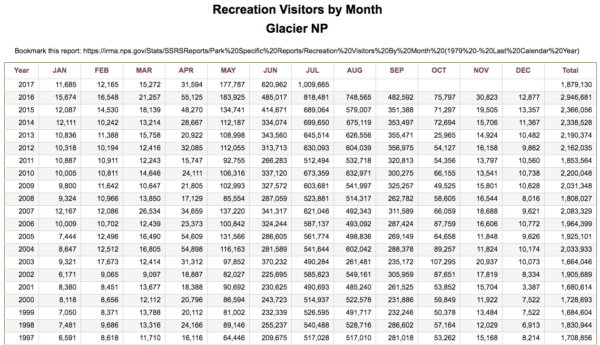Glacier National Park ushered more than 1 million visitors through its gates last month for the first time in history, shattering the previous monthly record and forecasting another groundbreaking summer for attendance.
Nearly 1,010,000 people visited Glacier Park in July compared to 818,500 monthly visitors last year for a 23.4 percent increase, or 191,184 additional visitors, according to National Park Service statistics.
“Surpassing a million visitors is definitely pretty significant for the park, and for the park service,” Lauren Alley, a spokesperson for Glacier, said Aug. 7. “For our staff that haven’t yet seen them, these numbers aren’t going to come as a surprise. It feels as busy as it is.”
Through the first seven months of 2017, Glacier has already attracted 1,998,628 visitors, a 17.7 percent increase over the first seven months of 2016.
After three consecutive years of record-breaking attendance, park officials are beginning to accept the frenetic pace of summer as the new normal, and Glacier Park staff recently hosted an emergency congestion management workshop to help prepare for challenges next year and into the future. Preliminary solutions include reconfiguring some parking areas and providing time-limited parking adjacent to restrooms and camp stores.
In the next week, the park will implement a one-hour time limit for approximately 60 parking spaces at Logan Pass. The intent of the time limit is to provide an opportunity for people hoping to make a quick stop, use the restroom, snap a few pictures, and go for a short walk to do so, according to a press release.
The workshop was hosted by the firm that is helping Glacier with its multi-year planning effort to address transportation and visitor use within the Going-to-the-Sun Road corridor, which experiences extreme crowding and congestion between June and August.
Visitor pressure has also increased substantially in other corners of the park, including the North Fork Flathead River area and Bowman Lake, the Two Medicine area and the Many Glacier area, stretching thin an already hard-pressed park staff hemmed in by budget reductions.
In addition to the increase in visitors, the park also saw a comparable increase in the number of emergency medical calls and total calls for ranger service. To date, the park has seen a 29 percent increase in emergency medical calls over the same time last year.
“Our calls for service, whether it’s visitors locked out of vehicles or medical services, are all tracking at about the same percentage increase over the last year,” Alley said of the attendance increase.
“Rangers have been stretched pretty thin responding to the increased number of calls this summer,” Superintendent Jeff Mow said.
This summer park officials have been reporting full parking lots at Logan Pass, Avalanche, Bowman Lake and other popular locations between 9-10 a.m. throughout the week. Campgrounds at all corners of the park are similarly brimming with eager, and oftentimes out-of-luck, visitors.
Over Fourth of July weekend, park rangers initiated a one-hour emergency temporary closure of the Many Glacier Valley for the first time due to gridlock conditions in hotel and trailhead parking areas and access roads, according to the NPS.
In the North Fork area and other areas of the park, rangers have had to temporarily restrict traffic to ensure that roads and parking areas remain accessible to emergency vehicles and do not become gridlocked.
“The numbers that we saw last year caused us to do more planning in anticipation for this year and how to implement traffic restrictions and ensure that we can move emergency vehicles in and out of the park,” Alley said. “We went into this year knowing that we might have to make some traffic restrictions, but we didn’t necessarily anticipate it being this busy.”
The West Entrance, the most popular entry point in the park, saw a 15.7 percent increase in visitors last month with 410,235 people. The St. Mary entrance was next with 289,116 people, a 46.9 percent increase over last year. Many Glacier drew 117,269 people, a 12 percent increase. Two Medicine drew 53,158 people, a 1.4 percent decline over July 2016.
Glacier has set annual attendance records for three consecutive years. Last year the national park drew 2.9 million visitors, a 24 percent increase over the annual record set in 2015.
To the north, in Waterton Lakes National Park in Alberta, Canada, Parks Canada is experiencing a similar strain on its resources, and last weekend was forced to turn visitors away at its gates due to heavy congestion.
“We understand this may be disappointing for visitors currently travelling to Waterton Lakes National Park and we appreciate their understanding. There are many alternate destinations in southwestern Alberta that offer similar experiences,” Parks Canada stated in a news release.
In the coming days and weeks, Mow asked that Glacier Park visitors arrive prepared for delays.
“We ask that visitors bring their patience, prepare for significant parking delays, and expect more people on the trails this summer,” said Superintendent Jeff Mow. “Glacier Country has a tremendous amount to offer its tourists. While people wait for times that are less crowded to visit the park, our surrounding public lands and local businesses can offer exceptional opportunities for people coming to see this spectacular region.”

